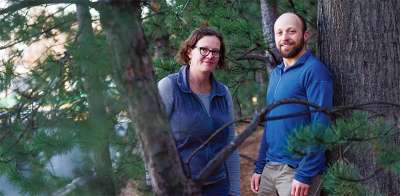
As human population grows, forests often become more and more fragmented as trees are cut down to make way for roads, housing developments, office parks, and shopping centers. Most research on forest fragmentation has examined its negative effects on wildlife and biodiversity. But two Boston University researchers recently investigated the effect of fragmentation on carbon storage and found some surprisingly positive news.
Associate Professor Lucy Hutyra and former BU post-doctoral researcher Andrew Reinmann, now an assistant professor at the City University of New York, discovered that trees at the edges of forests in southern New England grow faster and absorb more carbon than those in the interior. “When you create that edge, you essentially are reducing competition and freeing up more resources like light, water, and nutrients for trees,” Reinmann said, noting that the effect extends about 20 meters in from the forest edge. This finding was the result of studying 21 fragmented forest plots dominated by red oak in greater Boston. The researchers mapped every tree over 5 centimeters in diameter and collected cores from 210 trees at least 10 centimeters in diameter to get an estimate of the biomass of the forest and how it changes from the edge to the interior.
Reinmann said the faster growth rates and increased carbon absorption seen on forest edges are not a justification for further fragmenting the forested landscape. “When you fragment a forest, the remaining forest can offset a little bit of what was lost, but not completely,” he said. “So fragmentation may not be as terrible from a carbon perspective as we thought, but it is still bad.”
Further, the results of this research weren’t all positive: The cores collected also revealed that trees on the edge of a forest grow more slowly when they are stressed by heat – and as the climate changes and temperatures rise, heat stress is likely to increase.
The researchers defined heat stress as the number of days the forest was exposed to temperatures above 27 degrees Celsius in June and July, the months when most wood is produced. “That’s the average high temperature in July in the Boston area, so that’s the temperature the trees are used to growing in,” Reinmann said. “Any higher than that and we saw a decline in growth.”
That decline was most pronounced at the edge of the forest, where growth declined from heat stress three times faster than in the interior. “The forest edge is typically hotter than the interior,” he added, “so you would expect heat stress to be magnified at the edge because the trees aren’t buffered as the interior trees are.”
Based on the results of this study, Reinmann believes that climate models that calculate carbon storage in southern New England are likely underestimating how much carbon is being removed from the atmosphere because they are not including the positive “edge effect.” But as temperatures increase, that carbon benefit may decline significantly.

